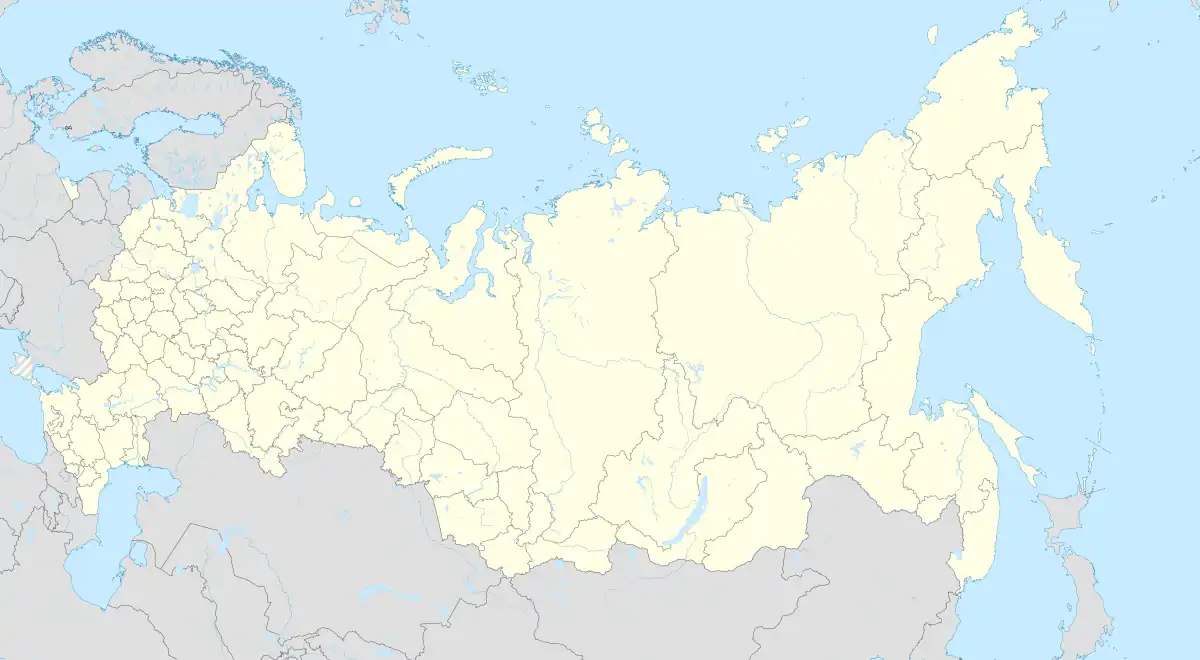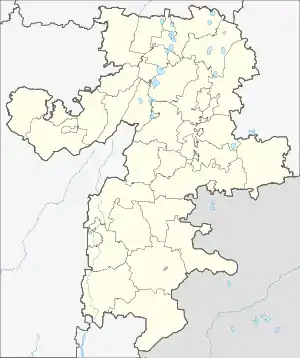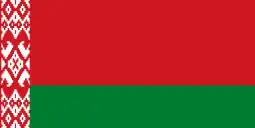Magnitogorsk
Магнитогорск | |
|---|---|
 | |
.svg.png.webp) Flag .png.webp) Coat of arms | |
Location of Magnitogorsk | |
 Magnitogorsk Location of Magnitogorsk  Magnitogorsk Magnitogorsk (Chelyabinsk Oblast) | |
| Coordinates: 53°23′N 59°02′E / 53.383°N 59.033°E | |
| Country | Russia |
| Federal subject | Chelyabinsk Oblast |
| Founded | 1743 |
| City status since | 1931 |
| Government | |
| • Mayor | Sergey Berdnikov |
| Elevation | 370 m (1,210 ft) |
| Population | |
| • Total | 407,775 |
| • Estimate (2018)[2] | 416,521 (+2.1%) |
| • Rank | 44th in 2010 |
| • Subordinated to | City of Magnitogorsk[3] |
| • Capital of | City of Magnitogorsk[3] |
| • Urban okrug | Magnitogorsky Urban Okrug[3] |
| • Capital of | Magnitogorsky Urban Okrug[3] |
| Time zone | UTC+5 (MSK+2 |
| Postal code(s)[5] | 455000 |
| Dialing code(s) | +7 3519 |
| OKTMO ID | 75738000001 |
| Website | www |
Magnitogorsk (Russian: Магнитого́рск, IPA: [məɡnʲɪtɐˈɡorsk], lit. '[city] of the magnetic mountain') is an industrial city in Chelyabinsk Oblast, Russia, on the eastern side of the extreme southern extent of the Ural Mountains by the Ural River. Population is 410,594 (2021 Census)[6]
It was named after Mount Magnitnaya, a geological anomaly that once consisted almost completely of iron ore, around 55% to 60% iron. It is the second-largest city in Russia that is not the administrative centre of any federal subject or district. Magnitogorsk contains the largest iron and steel works in the country: Magnitogorsk Iron and Steel Works. The official motto of the city is "the place where Europe and Asia meet", as the city occupies land in both Europe and Asia.
Magnitogorsk is one of only two planned socialist realist settlements ever built (the other being Nowa Huta in Poland).
History
Foundation
Magnitogorsk was founded in 1743 as part of the Orenburg Line of forts built during the reign of the Empress Elizabeth. By 1747 the settlement had grown large enough to justify the building of a small wooden chapel, later named "the Church of the Holy Trinity".
Russian iron-ore mining in this region dates back to 1752, when two entrepreneurs named Tverdysh and Myasnikov decided to explore the feasibility of mining in the area. They took advantage of the fact that Mount Magnitnaya did not belong to anyone at that time; they secured it for themselves by way of petition to Empress Elizabeth. In 1759 the petition was accepted, and they launched iron-ore production.
Growth
The city underwent rapid change in the 1930s when, according to Stalin's Five-Year-Plans, Magnitogorsk was to become a one-industry town modeled after two of the most advanced steel-producing cities in the United States at that time: Gary, Indiana, and Pittsburgh, Pennsylvania. At this time, hundreds of foreign experts streamed in to implement and direct the work.[7]
In 1928 a Soviet delegation arrived in Cleveland, Ohio, to discuss with American consulting company Arthur G. McKee a plan to set up in Magnitogorsk a copy of the US Steel steel-mill in Gary. The contract was increased four times, and eventually the new plant had a capacity of over four million tons annually.[8]
It was a showpiece of Soviet achievement. Huge reserves of iron ore in the area made it a prime location to build a steel plant capable of challenging its Western rivals. However, a large proportion of the workforce, as ex-peasants, typically had few industrial skills and little industrial experience. To solve these issues, several hundred foreign specialists arrived to direct the work, including a team of architects headed by the German Ernst May.
According to the original plans, the city was to have followed the linear city design, with rows of similar superblock neighborhoods running parallel to the factory, with a strip of greenery, or greenbelt, separating them. Planners would align living and production spheres so as to minimize necessary travel time: workers would generally live in a sector of the residential band closest to the sector of the industrial band in which they worked.
However, by the time that May completed his plans for Magnitogorsk, construction of both factory and housing had already started. The sprawling factory and enormous cleansing lakes had left little room available for development, and May therefore had to redesign his settlement to fit the modified site. This modification resulted in a city being more "rope-like" than linear. Although the industrial area is concentrated on the left bank of the river Ural, and most residential complexes are on its right bank, the city inhabitants are still subjected to noxious fumes and factory smoke.
The book Behind the Urals, by John Scott, documents the industrial development of Magnitogorsk during the 1930s. Scott discusses the fast-paced industrial and social developments during Stalin's first five-year plan and the rising paranoia of the Soviet regime preceding the Great Purge of the late 1930s.
Closed city
In 1937 foreigners were told to leave, and Magnitogorsk was declared a closed city. There is little reliable information about events and development of the city during the closed period.
The city played an important role during World War II because it supplied much of the steel for the Soviet war effort. Furthermore, its strategic location east of the Ural Mountains made Magnitogorsk safe from seizure by the German Army.[9]
Re-opening
During perestroika, the closed-city status was removed, and foreigners were allowed to visit the city again. The years after perestroika brought a significant change in the life of the city; the Iron and Steel Plant was reorganized as a joint-stock company Magnitogorsk Iron and Steel Works (MISW or MMK), which helped with the reconstruction of the railway and the building of a new airport.
With the depletion of the substantial local iron-ore reserves, Magnitogorsk has to import raw materials from Sokolvsko-Sarbaisky deposit in northern Kazakhstan.
Magnitogorsk building collapse
On December 31, 2018, an apartment block in the city of Magnitogorsk suffered a gas explosion and collapse which killed 39 of its residents, and injured 17 more.[10]
Administrative and municipal status
Within the framework of administrative divisions, it is incorporated as the City of Magnitogorsk—an administrative unit with the status equal to that of the districts.[3] As a municipal division, the City of Magnitogorsk is incorporated as Magnitogorsky Urban Okrug.[3]
Transport
The city is connected by the Magnitogorsk International Airport and by a railway. Public transport includes trams, buses, and taxis. The city is ranked 8th in the world and 2nd in Russia for automobile congestion.[11]
Education and culture
There are two establishments of higher education in Magnitogorsk: Magnitogorsk State Technical University (MSTU) and Magnitogorsk State Conservatory (MSC). Magnitogorsk State University (MaSU), founded in 1932, in 2013 was merged with MSTU and ceased to exist as a separate university.
There are also three theatres: Pushkin Drama Theatre (the oldest in the city), the Opera and Ballet House, and the Puppet Theatre. The Church of the Ascension of the Lord opened in 2004.

_10.jpg.webp)
Sports
Metallurg Magnitogorsk is an ice hockey team based in Magnitogorsk, playing in the Kontinental Hockey League. Evgeni Malkin (b. 1986) of the Pittsburgh Penguins, Ilya Samsonov of the Toronto Maple Leafs and Nikolai Kulemin (b. 1986) of the New York Islanders both used to play for the club and both are Magnitogorsk natives. Metallurg Magnitogorsk won the Gagarin Cup in 2013–14 KHL season and 2015-16 KHL season.
The town's football team is FC Magnitogorsk, playing in the Amateur Football League. Abzakovo is a popular mountain skiing base nearby, built by the MMK.
Several sports clubs are active in the city:
| Club | Sport | Founded | Current league | League rank | Stadium |
|---|---|---|---|---|---|
| Metallurg Magnitogorsk | Ice hockey | 1955 | Kontinental Hockey League | 1st | Arena Metallurg |
| Stalnye Lisy | Ice hockey | 2009 | Junior Hockey League | Jr. 1st | Arena Metallurg |
| Magnitka-Universitet | Basketball | ? | Men's Basketball Supreme League | 3rd | MGTU Sports Hall |
Geography
The city is located on the eastern side of the extreme southern extent of the Ural Mountains by the Ural River.
Magnitogorsk was mentioned in the Blacksmith Institute's 2007 survey of the world's worst polluted cities, placed in the report's unranked list of the 25 most-polluted places outside the top ten. Pollutants include lead, sulfur dioxide, heavy metals and other air pollutants. According to the local hospital, only 1% of all children living in the city are in good health. The Blacksmith Institute says that, according to a local newspaper report, "only 28% of infants born in 1992 were healthy, and only 27% had healthy mothers". However, according to Blacksmith Institute, plant managers have upgraded much of their equipment in recent years and emissions have been reduced by about 60%.[12]
Climate
Magnitogorsk has a distinct four-season humid continental climate[13] (Dfb) with relatively severe winters for the latitude. This climate type is typical for southerly Russian areas far from large bodies of water. The average July high is around 25 °C (77 °F) with lows of 13 °C (55 °F) with January averages ranging from −10 °C (14 °F) in daytime high to −18 °C (0 °F) in average low.[14] Temperatures approaching 34 °C (93 °F) or above have been measured from May to September with real severe frosts below −36 °C (−33 °F) have been measured in all other months than that except transitional months April and October.[14]
| Climate data for Magnitogorsk (1991–2020, extremes 1948–present) | |||||||||||||
|---|---|---|---|---|---|---|---|---|---|---|---|---|---|
| Month | Jan | Feb | Mar | Apr | May | Jun | Jul | Aug | Sep | Oct | Nov | Dec | Year |
| Record high °C (°F) | 3.0 (37.4) |
4.6 (40.3) |
16.5 (61.7) |
30.1 (86.2) |
34.8 (94.6) |
38.5 (101.3) |
38.9 (102.0) |
37.2 (99.0) |
35.1 (95.2) |
24.3 (75.7) |
15.8 (60.4) |
8.2 (46.8) |
39.1 (102.4) |
| Mean daily maximum °C (°F) | −10.1 (13.8) |
−8.4 (16.9) |
−1.4 (29.5) |
10.9 (51.6) |
20.1 (68.2) |
24.5 (76.1) |
25.4 (77.7) |
24.0 (75.2) |
17.6 (63.7) |
9.2 (48.6) |
−1.3 (29.7) |
−8.0 (17.6) |
8.5 (47.3) |
| Daily mean °C (°F) | −14.3 (6.3) |
−13.4 (7.9) |
−6.3 (20.7) |
4.7 (40.5) |
13.0 (55.4) |
17.9 (64.2) |
19.3 (66.7) |
17.4 (63.3) |
11.1 (52.0) |
3.9 (39.0) |
−5.3 (22.5) |
−12.1 (10.2) |
3.0 (37.4) |
| Mean daily minimum °C (°F) | −18.6 (−1.5) |
−18.2 (−0.8) |
−11.0 (12.2) |
−0.9 (30.4) |
6.0 (42.8) |
11.1 (52.0) |
13.2 (55.8) |
11.2 (52.2) |
5.3 (41.5) |
−0.7 (30.7) |
−9.1 (15.6) |
−16.2 (2.8) |
−2.3 (27.9) |
| Record low °C (°F) | −42.8 (−45.0) |
−42.8 (−45.0) |
−36.1 (−33.0) |
−23.9 (−11.0) |
−8.9 (16.0) |
−2.8 (27.0) |
3.2 (37.8) |
0.0 (32.0) |
−11.1 (12.0) |
−21.0 (−5.8) |
−36.1 (−33.0) |
−38.9 (−38.0) |
−42.8 (−45.0) |
| Average precipitation mm (inches) | 20 (0.8) |
19 (0.7) |
23 (0.9) |
27 (1.1) |
31 (1.2) |
37 (1.5) |
56 (2.2) |
44 (1.7) |
25 (1.0) |
27 (1.1) |
24 (0.9) |
19 (0.7) |
352 (13.9) |
| Average extreme snow depth cm (inches) | 17 (6.7) |
25 (9.8) |
23 (9.1) |
2 (0.8) |
0 (0) |
0 (0) |
0 (0) |
0 (0) |
0 (0) |
1 (0.4) |
4 (1.6) |
11 (4.3) |
25 (9.8) |
| Average rainy days | 0.1 | 0.2 | 2 | 7 | 12 | 13 | 15 | 13 | 12 | 9 | 4 | 0.4 | 88 |
| Average snowy days | 17 | 14 | 11 | 5 | 1 | 0.2 | 0 | 0.1 | 1 | 6 | 13 | 15 | 83 |
| Average relative humidity (%) | 83 | 80 | 80 | 67 | 58 | 60 | 67 | 68 | 69 | 73 | 81 | 82 | 72 |
| Source: Pogoda.ru.net[15] | |||||||||||||
Demographics
| Year | Pop. | ±% |
|---|---|---|
| 1939 | 146,000 | — |
| 1959 | 311,101 | +113.1% |
| 1970 | 364,209 | +17.1% |
| 1979 | 406,074 | +11.5% |
| 1989 | 440,321 | +8.4% |
| 2002 | 418,545 | −4.9% |
| 2010 | 407,775 | −2.6% |
| 2021 | 410,594 | +0.7% |
| Source: Census data | ||
Ethnic composition (2010):.[16]
| Ethnicity | Population | Percentage |
|---|---|---|
| Russians | 338,595 | 84.7% |
| Tatars | 20,433 | 5.2% |
| Bashkirs | 15,172 | 3.9% |
| Ukrainians | 6,101 | 1.6% |
| Kazakhs | 4,130 | 1.0% |
| Others | 13,883 | 3.6% |
Twin towns – sister cities
Magnitogorsk is twinned with:[17]
 Atyrau, Kazakhstan
Atyrau, Kazakhstan Brandenburg an der Havel, Germany
Brandenburg an der Havel, Germany Daugavpils, Latvia
Daugavpils, Latvia Gomel, Belarus
Gomel, Belarus Huai'an, China
Huai'an, China
References
Notes
- ↑ Russian Federal State Statistics Service (2011). Всероссийская перепись населения 2010 года. Том 1 [2010 All-Russian Population Census, vol. 1]. Всероссийская перепись населения 2010 года [2010 All-Russia Population Census] (in Russian). Federal State Statistics Service.
- ↑ "26. Численность постоянного населения Российской Федерации по муниципальным образованиям на 1 января 2018 года". Federal State Statistics Service. Retrieved January 23, 2019.
- 1 2 3 4 5 6 Resolution #161
- ↑ "Об исчислении времени". Официальный интернет-портал правовой информации (in Russian). June 3, 2011. Retrieved January 19, 2019.
- ↑ Почта России. Информационно-вычислительный центр ОАСУ РПО. (Russian Post). Поиск объектов почтовой связи (Postal Objects Search) (in Russian)
- ↑ Russian Federal State Statistics Service. Всероссийская перепись населения 2020 года. Том 1 [2020 All-Russian Population Census, vol. 1] (XLS) (in Russian). Federal State Statistics Service.
- ↑ "Magnetic Mountain". Seventeen Moments in Soviet History. June 17, 2015. Retrieved January 19, 2019.
- ↑ Ball, Alan M. (April 2, 2018). Imagining America: Influence and Images in Twentieth-century Russia. Rowman & Littlefield Publishers. ISBN 9780742527935. Retrieved April 2, 2018 – via Google Books.
- ↑ McCollough, J. Brady (February 8, 2014). "Evgeni Malkin: A Russian tale with roots founded in ice and iron". Pittsburgh Post-Gazette. Retrieved February 28, 2016.
- ↑ "Спасательная операция на месте обрушения подъезда в Магнитогорске завершена. (Rescue operation at the site of the entrance collapse in Magnitogorsk completed)". Interfax.ru (in Russian). Retrieved June 20, 2021.
- ↑ INRIX. "Magnitogorsk's Scorecard Report". INRIX - INRIX. Retrieved April 2, 2018.
- ↑ The World's Worst Polluted Places: The Top Ten, Blacksmith Institute, September 2007
- ↑ "Magnitogorsk, Russia Climate Summary". Weatherbase. Retrieved December 28, 2014.
- 1 2 "Magnitogorsk, Russia Weather Averages". Weatherbase. Retrieved December 28, 2014.
- ↑ "Weather and Climate - The Climate of Magnitogorsk" (in Russian). Weather and Climate (Погода и климат). Retrieved November 8, 2021.
- ↑ "Наиболее многочисленные национальности" (PDF). Rosstat. Archived from the original (PDF) on August 22, 2016. Retrieved September 11, 2016.
- ↑ "Города-побратимы". magnitogorsk.ru (in Russian). Magnitogorsk. Retrieved February 3, 2020.
Sources
- Законодательное Собрание Челябинской области. Постановление №161 от 25 мая 2006 г. «Об утверждении перечня муниципальных образований (административно-территориальных единиц) Челябинской области и населённых пунктов, входящих в их состав», в ред. Постановления №2255 от 23 октября 2014 г. «О внесении изменений в перечень муниципальных образований (административно-территориальных единиц) Челябинской области и населённых пунктов, входящих в их состав». Вступил в силу со дня официального опубликования. Опубликован: "Южноуральская панорама", №111–112, 14 июня 2006 г. (Legislative Assembly of Chelyabinsk Oblast. Resolution #161 of November 25, 2006 On Adoption of the Registry of the Municipal Formations (Administrative-Territorial Units) of Chelyabinsk Oblast and of the Inhabited Localities They Comprise, as amended by the Resolution #2255 of October 23, 2014 On Amending the Registry of the Municipal Formations (Administrative-Territorial Units) of Chelyabinsk Oblast and of the Inhabited Localities They Comprise. Effective as of the official publication date.).
- Scott, John, Behind the Urals: An American Worker in Russia's City of Steel, Indiana University Press, 1989. ISBN 0-253-20536-0
- Degtyarev A. G., Letopis' gory Magnitnoy i goroda Magnitogorska, 1993.
- Kotkin, Stephen. Steeltown, USSR:Soviet Society in the Gorbachev Era
- Kotkin, Stephen, Magnetic Mountain: Stalinism as a Civilization.
Further reading
- Scott, John (1989). Behind the Urals: An American Worker in Russia's City of Steel (Enlarged ed.). Bloomington, IN: Indiana University Press. p. 306. ISBN 0-253-35125-1.
- Kotkin, Stephen (1995). Magnetic Mountain: Stalinism as a Civilization. Berkeley and Los Angeles, California: University of California Press. p. 639. ISBN 0520069080.
Kotkin, Stephen Steeltown, USSR date 1991. Publisher U. of California Press.
External links
- Official Magnitogorsk Administration Site (in English)
- http://www.dialogpress.ru/ Magnitogorsk Main News
- http://macalester.edu/courses/geog61/aritz/magnitogorsk.html Archived January 27, 2008, at the Wayback Machine Macalester College site about Magnitogorsk
- Magnitogorsk and Vicinity (Abzakovo, Bannoye)
- Magnitogorsk Photos (in Russian)
